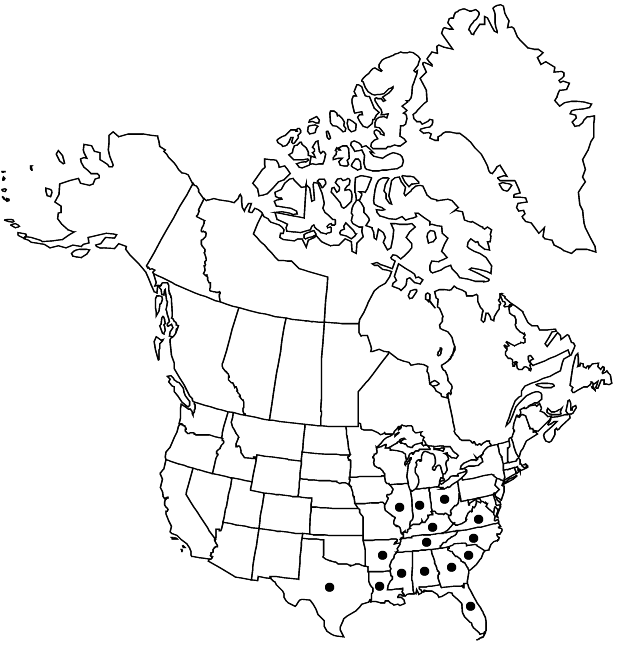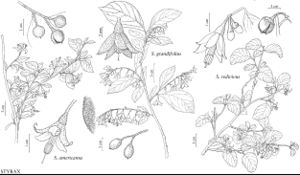Difference between revisions of "Styrax grandifolius"
Hort. Kew. 2: 75. 1789 (as grandifolium) ,.
FNA>Volume Importer |
FNA>Volume Importer |
(No difference)
| |
Revision as of 20:30, 24 September 2019
Shrubs or trees, to 6 m, often suckering extensively from roots. Leaves: petiole 4–12 mm; blade with 5–8 secondary veins, obovate to broadly elliptic or broadly rhombic, 7–20 × 4–14.3 cm, largest blades on sterile shoots 5–20 cm wide, margins of at least some leaves on sterile shoots (and often fertile shoots) denticulate to serrate, rarely also lobed, longest arms of abaxial hairs 0.2–0.6 mm. False-terminal inflorescences 2–19-flowered or solitary flower, 3–11.5 cm; axillary flowers present on at least some shoots (subtending leaves often reduced). Pedicels 4–9 mm, usually shorter than calyx. Flowers: calyx 4–6 × 3–6 mm; corolla 10–21 mm, tube 3–5 mm, lobes 5(–6), imbricate in bud, slightly reflexed, elliptic, 8–16 × 3–7 mm; filaments distinct beyond adnation to corolla. Nutlike fruits globose to subglobose, 8–12 × 6–8 mm (broader when 2–3-seeded), gray to yellowish gray stellate-pubescent, indehiscent or at most with 1–3 narrow longitudinal fissures, barely exposing seed(s); fruit wall 0.4–0.5 mm thick. 2n = 32.
Phenology: Flowering Apr–May; fruiting Jun–Oct.
Habitat: Upland woods, ravines, rocky banks, bluffs, outcrops, usually sandy soils
Elevation: 0-300 m
Distribution

Ala., Ark., Fla., Ga., Ill., Ind., Ky., La., Miss., N.C., Ohio, S.C., Tenn., Tex., Va.
Discussion
Small-leaved sterile specimens of Styrax grandifolius can usually be distinguished from S. americanus by the hairs on the abaxial leaf blade surface, and the shape of the leaves (particularly those at the distal end of new sterile shoots), which are usually obovate to broadly rhombic versus usually elliptic in S. americanus.
Selected References
None.
